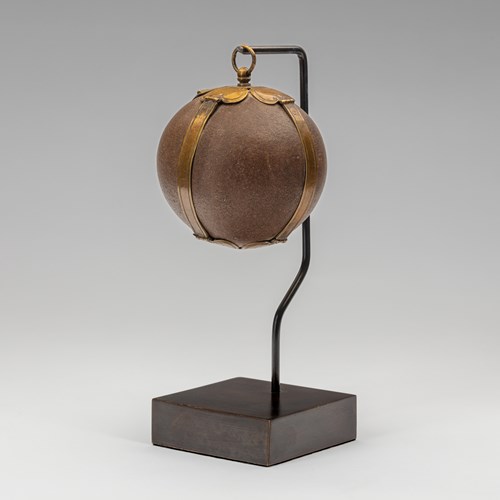Porcelain Ewer Made for the Islamic Market
Period 1572-1620, Wanli reign period
Origin China, Jingdezhen
Medium Porcelain decorated in underglaze cobalt blue
Dimension 30.5 x 14 cm (12 x 5¹/₂ inches)
The ewer is decorated in underglaze cobalt blue, a pigment that had originally been introduced to China from Iran in the eighth century CE. On the body is a design of dragons chasing the flaming pearls of wisdom and the flaming pearls also adorn the spout. A panel of baoxiang “treasure flowers” flows round the lower neck with a band of plantain leaves above it. Round the high base are bands of looping swags, some of them in the shape of the magic fungus of immortality. The delicate spout is joined to the body by a strut, while a loop on the top of the handle was to attach a chain to a lid, which is now lost.
On the base of the ewer is a crouching hare, painted inside a patch of blue. In Chinese mythology, the hare is the fourth creature in the zodiac that leads the sun through the twelve terrestrial branches of the zodiac and resides in the moon. The dark shadows that one can see on the surface of the moon are said to resemble the outline of the hare, pounding cinnamon twigs for immortality in a mortar and pestle. Lunar festivities are held in China on the day of the eighth lunar month, when the depiction of a hare expresses the wish that the children will rise in the social scale and enjoy a peaceful life.1 The design of a hare on a blue ground was sometimes painted on the base of export porcelain during the Wanli period.2 Some experts believe that it denotes the trademark of an individual workshop within the vast porcelain manufacturing city of Jingdezhen.
A Wanli period ewer of similar hexagonal shape and of near-identical size is in the Victoria and Albert Museum in London (Accession Number: 174-1879). It bears a German gilt metal mount, indicating that Chinese porcelain ewers for the Islamic market also travelled further westwards to Europe.
Footnotes:
1. Wolfram Ederhard. 2015. Dictionary of Chinese Symbols: Hidden Symbols in Chinese Life and Thought. Routledge: London. p.140.
2. See for example Jorge Welsh. 2008. Kraak Porcelain. The Rise of Global Trade in the Late 16th and Early 17th Centuries. London and Lisbon, Gorge Welsh Research and Publishing. p.110.
Stock no.: A5117
Period: 1572-1620, Wanli reign period
Origin: China, Jingdezhen
Medium: Porcelain decorated in underglaze cobalt blue
Dimension: 30.5 x 14 cm (12 x 5¹/₂ inches)
Literature: Footnotes:
1. Wolfram Ederhard. 2015. Dictionary of Chinese Symbols: Hidden Symbols in Chinese Life and Thought. Routledge: London. p.140.
2. See for example Jorge Welsh. 2008. Kraak Porcelain. The Rise of Global Trade in the Late 16th and Early 17th Centuries. London and Lisbon, Gorge Welsh Research and Publishing. p.110.
More artworks from the Gallery






_T638657944608893064.jpg?width=500&height=500&mode=pad&scale=both&qlt=90&format=jpg)


_T637910593807181500.jpg?width=500&height=500&mode=pad&scale=both&qlt=90&format=jpg)